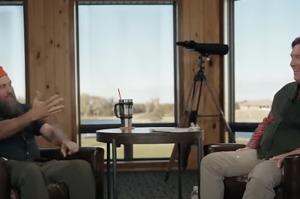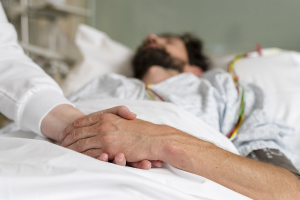The Supreme Court Decision: One Small Step for Mankind
Now that the dust has settled and we have had a chance to absorb the Supreme Court's recent decision in Gonzales v. Carhart, which upheld the facial constitutional validity of the national ban on partial birth abortion, we can step back and assess the significance of the Court's decision. In the immediate aftermath of the decision, some in the pro-life community hailed it as a huge advance, while others who support abortion decried it as a major setback.
Unfortunately, it is neither.
At best, this decision represents a small step forward in our long struggle to protect the lives of unborn children. While it is significant that this is a step forward, it would be excessively optimistic to imagine that the Carhart ruling has paved the way for the overturning of Roe v. Wade. What is clear from the opinion is that the court continues to use the principles of Roe and Planned Parenthood v. Casey, as its benchmarks for measuring the constitutionality of abortion legislation. Carhart does nothing to erode these cases, which have bedeviled the pro-life community and led to the destruction of tens of millions of unborn children.
In a nutshell, the Court continues to labor under the assumption that the individual living in a mother's womb is something other than a human being. No amount of legal precedents can change the medical, scientific, and ethical reality: the fetus is both alive and it is human. It is human life. There is absolutely no logical reason why this human life should be less protected under the law than any other human life. The Supreme Court of the United States does not have the authority to redefine the nature of reality, and simply because it has a history of redefining reality does not mean it should continue to do so. The logic of Roe and Casey must be rejected.
Personhood and humanity are not a function of age, size or location. The progeny of human beings are human beings. One may be a young human being as opposed to an old one, or a small one instead of a big one, but they are human beings nonetheless. Nothing magical happens between the time when a baby is in the womb at one moment, and outside the womb at the next. There is no mystery about what lies within a woman's womb. It is not a goldfish or a grasshopper. It is a human being. Until the court acknowledges that an unborn child is truly a "person" (and thereby entitled to the protections that are accorded to other persons in our constitutional republic), unborn children will continue to be destroyed at the whim of their mothers.
At certain points in the decision the fetus is referred to as an "unborn child" or a baby (which makes Justice Ginsburg bristle), but at other times some of the most grisly procedures imaginable are described in cold, detached language. For example:
The woman is placed under general anesthesia or conscious sedation. The doctor, often guided by ultra-sound, inserts grasping forceps through the woman's cervix and into the uterus to grab the fetus. The doctor grips a fetal part with the forceps and pulls it back through the cervix and vagina, continuing to pull even after meeting resistance from the cervix. The friction causes the fetus to tear apart. For example, a leg might be ripped off the fetus as it is pulled through the cervix and out of the woman. The process of evacuating the fetus piece by piece continues until it has been completely removed.
One wonders about the moral state of a nation that is able to discuss so gruesome an act with such apparent disinterest. Shockingly, this act is still legal in America because it is does not fall under the definition of partial birth abortion. How could the Supreme Court possibly hold that this "procedure" is protected by the Constitution of the United States? Nevertheless, the majority opinion maintains the assumption of Casey that it is a mother's right to choose such a death for her baby.
Justice Ginsberg maintains that a woman is not truly free unless she is free to destroy the life of her unborn child. She says:
As Casey comprehended, at stake in cases challenging abortion restrictions is a woman's "control over her [own] destiny." "There was a time, not so long ago," when women were "regarded as the center of home and family life, with attendant special responsibilities that precluded full and independent legal status under the Constitution." Those views, this Court made clear in Casey, "are no longer consistent with our understanding of the family, the individual, or the Constitution." Women, it is now acknowledged, have the talent, capacity, and right "to participate equally in the economic and social life of the Nation." Their ability to realize their full potential, the Court recognized, is intimately connected to "their ability to control their reproductive lives."
Justice Ginsburg has a perverse view of freedom and confuses liberty with license. To say that a person can only be free if they are allowed to destroy their own children strikes at the very heart of society. A nation that has come to see new life as an unacceptable burden is a nation that has lost its humanity.
Only two judges, Scalia and Thomas, were willing to call a spade a spade. They wrote a concurring opinion indicating that they felt that the court's abortion jurisprudence has no basis in the Constitution. Chief Justice Roberts and Justice Alito did not join them in this opinion, but that does not necessarily mean that they do not agree; they were simply not willing to show their cards just yet. Nevertheless, the inescapable fact is that unless three more judges come to agree with Scalia and Thomas, we will continue to have rampant abortion across America.
The Carhart decision ultimately begs the question: who is a person? Though it is a step forward, it is still a very small step. In the aftermath of Carhart, it is apparent that we must redouble our efforts to turn this small step into true forward progress.
___________________________________________________
Ken Connor is Chairman of the Center for a Just Society in Washington, DC and a nationally recognized trial lawyer who represented Governor Jeb Bush in the Terri Schiavo case. Connor was formally President of the Family Research Council, Chairman of the Board of CareNet, and Vice Chairman of Americans United for Life. For more articles and resources from Mr. Connor and the Center for a Just Society, go to www.ajustsociety.org. Your feedback is welcome; please email [email protected]



























